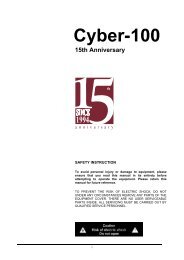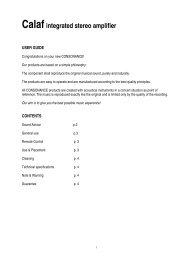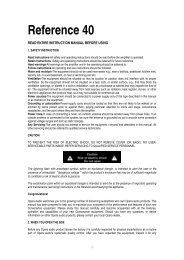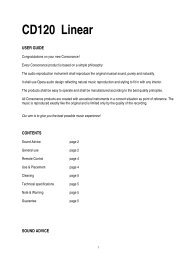Opera Audio Consonance CD-120 Linear CD Player - Alium Audio
Opera Audio Consonance CD-120 Linear CD Player - Alium Audio
Opera Audio Consonance CD-120 Linear CD Player - Alium Audio
You also want an ePaper? Increase the reach of your titles
YUMPU automatically turns print PDFs into web optimized ePapers that Google loves.
EQUIPMENT REVIEW<br />
<strong>Opera</strong> <strong>Audio</strong> <strong>Consonance</strong><br />
<strong>CD</strong>-<strong>120</strong> <strong>Linear</strong> <strong>CD</strong> <strong>Player</strong><br />
by Jimmy Hughes<br />
In retrospect I initially misjudged the<br />
<strong>CD</strong>-<strong>120</strong> <strong>Linear</strong>. While I liked it from the<br />
start, it nevertheless took a while before<br />
I fully appreciated just how good it<br />
actually was. Don’t get me wrong; all<br />
the early signs were favourable. But,<br />
following on from the Chord DAC-64,<br />
the <strong>CD</strong>-<strong>120</strong> <strong>Linear</strong> seemed somewhat<br />
less immediate and assertive in terms of<br />
its musical presentation. It was certainly<br />
pleasant to listen to, and from the start it<br />
was obvious that its sound was both<br />
friendly and inviting. Only gradually did<br />
it become clear that all this was just<br />
the tip of the iceberg. Behind that<br />
cultivated exterior there’s actually<br />
a remarkable amount going on.<br />
The <strong>CD</strong>-<strong>120</strong> <strong>Linear</strong> is deceptively<br />
subtle and surprisingly detailed. It<br />
can appear smooth, understated, and<br />
(seemingly) laid back and relaxed.<br />
But you’d be wrong to conclude it<br />
lacks teeth. In many respects it’s very<br />
Analogue. It has that easy refined<br />
naturalness you get from LP at its best.<br />
You really notice this with massed<br />
choral forces; the sound has a delicious<br />
openness that simply sounds right.<br />
There’s no exaggeration - no undue<br />
emphasis of sibilants or shifts of tonality.<br />
Dynamics are impressive, but not in an<br />
aggressive ‘in your face’ manner. Instead,<br />
you get the impression of the music<br />
expanding and growing naturally and<br />
effortlessly as dynamic levels increase.<br />
By comparison, the Chord DAC-64<br />
gives a more assertive and perhaps more<br />
exciting musical presentation. It creates<br />
a more acute sense of things happening.<br />
The <strong>CD</strong>-<strong>120</strong> <strong>Linear</strong> is superficially less<br />
brilliant, but this is deceptive. The sound<br />
is truer and more natural, with much<br />
finer differentiation of subtle tone<br />
colours and dynamics. The better your<br />
system, the more this will become<br />
apparent. During a lengthy review<br />
period, I changed amplifiers three times,<br />
and as I did so (and things improved)<br />
the special qualities of the <strong>CD</strong>-<strong>120</strong> <strong>Linear</strong><br />
became more and more apparent.<br />
For starters, it’s unusually<br />
holographic for a <strong>CD</strong> planer, creating<br />
a real sense of space width and depth.<br />
This became especially noticeable<br />
when I started using the Prima Luna<br />
Prologue 3 and 5<br />
amplifiers.<br />
The way the<br />
<strong>CD</strong>-<strong>120</strong> <strong>Linear</strong><br />
images is impressive.<br />
The soundstage has excellent left/right<br />
width and a truly palpable sense of<br />
depth, and this creates a vivid holographic<br />
effect whereby the music sounds<br />
three-dimensional. That two-channel<br />
stereo can create the impression of a<br />
spacious acoustic that exists between<br />
and beyond the boundaries set by the<br />
loudspeakers is one of the unexplained<br />
mysteries of hi-fi.<br />
Although <strong>CD</strong> typically produces<br />
sharp clean images with wide dynamic<br />
contrasts, it rarely if ever achieves<br />
comparable dimensionality to a good LP<br />
on a top-class analogue front-end. While<br />
I’m not claiming the <strong>CD</strong>-<strong>120</strong> <strong>Linear</strong> fully<br />
equals or beats the best turntables, it<br />
nonetheless produces a beautifully<br />
subtle and holographic soundstage that’s<br />
Reproduced from Hi-Fi+ Issue 44<br />
unusually natural and open. By typical<br />
<strong>CD</strong> standards it’s exceptionally smooth<br />
and uncoloured, with a delicate<br />
openness that is very engaging. It’s<br />
not a <strong>CD</strong> player that immediately<br />
strikes the ear as ‘impressive’, yet who<br />
could fail to be impressed when faced<br />
with such realistic results? The more<br />
you listen, the more engaging it gets.<br />
At least that’s what I found.<br />
As a <strong>CD</strong> transport (forgetting sound<br />
quality for a moment) the <strong>CD</strong>-<strong>120</strong> <strong>Linear</strong><br />
is nothing much to write home about.<br />
Track access is lazy, as though the player<br />
had to think for a few seconds before<br />
executing your command. In this and<br />
one or two other respects, the<br />
<strong>CD</strong>-<strong>120</strong> <strong>Linear</strong> reminds me of <strong>CD</strong><br />
players from the early 1980s. It’s<br />
frustratingly slow after a typical<br />
modern player. In particular, the<br />
drawer mechanism was a bit clunky,<br />
and, on the review sample, would not<br />
fully open or close without a pull or<br />
push –hopefully a local fault, and not<br />
something that afflicts other examples.<br />
Display Off is offered – a useful<br />
feature that (with some <strong>CD</strong> players)<br />
can sometimes improve sound quality.<br />
Unfortunately, once you’ve switched off<br />
the display – that’s it; off it stays! Unlike<br />
some more advanced <strong>CD</strong> players, the<br />
display doesn’t temporarily light again<br />
– when you press Stop or Pause, for<br />
example. Unless you select Display On<br />
via the supplied remote handset, the<br />
lights stay off. You’ve the option of<br />
dimming the display, or switching it off<br />
altogether. Now, it could have been<br />
imagination, but I thought the sound<br />
might’ve been fractionally cleaner with<br />
the display switched off. But, if there was<br />
a difference, it wasn’t a very big one.<br />
A single set of unbalanced<br />
81
EQUIPMENT REVIEW<br />
analogue outputs are provided, plus<br />
a digital output for an external DAC.<br />
Shrewdly, given the <strong>CD</strong>-<strong>120</strong> <strong>Linear</strong>’s<br />
natural unexaggerated sound, the<br />
manufacturers have increased the<br />
analogue output slightly to 2.35 V,<br />
compared to the more normal 2 V. This<br />
gives the <strong>CD</strong>-<strong>120</strong> <strong>Linear</strong> marginally<br />
greater drive, subjectively helping to<br />
suggest increased presence and<br />
dynamic attack. If you’re making<br />
A/B comparisons with other <strong>CD</strong><br />
players, be aware that the <strong>CD</strong>-<br />
<strong>120</strong> <strong>Linear</strong> may well sound a<br />
fraction louder at the same<br />
volume level because of this<br />
slightly increased output.<br />
The <strong>CD</strong>-<strong>120</strong> <strong>Linear</strong> uses a<br />
16bit TDA 1543 D/A Converter,<br />
and does not have a digital filter<br />
on the output. This is its magic<br />
ingredient. For those interested, there’s<br />
a link from the company’s website to<br />
an article written by Japanese engineer<br />
Ryohei Kusunoki who first advocated<br />
this approach, explaining (in rather<br />
fractured English) his rationale. Put<br />
simply, it boils<br />
down to<br />
the cure being<br />
worse than the disease. So, <strong>Consonance</strong><br />
ditch the digital filter, and in doing so<br />
claim much improved phase linearity<br />
and better timing, with less smearing<br />
of the extreme highs.<br />
Certainly, the <strong>CD</strong>-<strong>120</strong> <strong>Linear</strong> has<br />
audibly less of that tonally ‘hard’ closedin<br />
effect one typically associates with<br />
<strong>CD</strong> – it’s without doubt unusually natural<br />
and open sounding. Kusunoki argues<br />
that <strong>CD</strong>’s sonic problems are largely<br />
caused by the digital filter, and claims<br />
82<br />
the adverse effects of this filter have far<br />
more significant effects on sound quality<br />
than the imposed limitations of <strong>CD</strong>’s<br />
44.1kHz 16bit specification. Judging by<br />
the sonic performance of the <strong>CD</strong>-<strong>120</strong><br />
<strong>Linear</strong>, he may well be right – though<br />
I daresay there are other<br />
factors too.<br />
The <strong>CD</strong>-<strong>120</strong> <strong>Linear</strong><br />
can either sample at regular<br />
44.1kHz,or at 88.2kHz – this being<br />
accessed from the remote control.<br />
Comparing 88.2kHz with standard<br />
44.1kHz, the latter sounds slightly<br />
edgier and a shade more congested.<br />
The 88.2kHz option sounds noticeably<br />
cleaner and more trans-parent, with less<br />
of that electronic ‘edge’ and congestedness<br />
one so easily gets with massed<br />
violins and voices. In 88.2kHz mode, the<br />
<strong>CD</strong>-<strong>120</strong> <strong>Linear</strong> is much more of an open<br />
window on the recording being played,<br />
sounding clear, sweet, transparent,<br />
and very natural.<br />
It was pleasant to listen to, but<br />
engaging too - making the music<br />
sound interesting and involving.<br />
At the same time the actual sound<br />
itself was easy to ‘forget’; it had presence<br />
and colour, yet did not draw<br />
attention to itself. Again, these are very<br />
Analogue sorts of qualities. The total<br />
effect was very natural and believable,<br />
and once acclimatised to the way the<br />
<strong>CD</strong>-<strong>120</strong> <strong>Linear</strong> did things, I did not feel<br />
it lacked brilliance, clarity, or separation<br />
– indeed, quite the opposite.<br />
My final surprise was price. I wasn’t<br />
aware of the <strong>CD</strong>-<strong>120</strong> <strong>Linear</strong>’s very<br />
reasonable cost when I first began<br />
listening to it, and was agreeably<br />
shocked and pleased to learn how<br />
little it will set you back (in audiophile<br />
Reproduced from Hi-Fi+ Issue 44<br />
terms). It easily gives Chord’s DAC-64<br />
a run for its money, and actually beats<br />
it in terms of relaxed smoothness and<br />
unexaggerated natural-ness. If you prefer<br />
your music with a bit more attitude and<br />
excitement, the Chord still has the edge<br />
– but not by much.<br />
Sometimes a new component<br />
has you excitedly going through<br />
your favourite recordings,<br />
listening out for fresh details or<br />
new revelations. The <strong>CD</strong>-<strong>120</strong><br />
<strong>Linear</strong> had me doing just<br />
that; I was curious as to<br />
what it might make of each new<br />
recording I tried. But, rather than sitting<br />
there on the edge of my seat waiting and<br />
hoping to be impressed, it was more a<br />
case of just leaning back and enjoying<br />
the results. It’s definitely a <strong>CD</strong> player that<br />
appeals to your heart and emotions –<br />
though that isn’t to say it doesn’t stand<br />
up to being analysed; it does.<br />
The <strong>CD</strong>-<strong>120</strong> <strong>Linear</strong> is a curious mix<br />
of apparently conflicting opposites. It<br />
produces natural and unexaggerated<br />
results that aren’t ‘impressive’ in loud or<br />
extrovert terms. Yet at the same time you<br />
could never claim the results are bland<br />
or faceless. The music is reproduced in<br />
a deeper more meaningful way than<br />
one often finds with silver disc. The<br />
<strong>CD</strong>-<strong>120</strong> <strong>Linear</strong> is a very musical <strong>CD</strong><br />
player – one of just a few able to make<br />
digital sound like good analogue.<br />
TECHNICAL SPECIFICATIONS<br />
Type:<br />
Integrated <strong>CD</strong> <strong>Player</strong><br />
Chip-set: 16 bit TDA 1543 x2<br />
Outputs: 1pr single-ended RCA/phono<br />
1x co-axial digital<br />
Output Level: 2.35 V<br />
Dimensions (WxHxD): 430 x 85 x 320mm<br />
Weight:<br />
10kg<br />
Finish:<br />
Silver<br />
Price: £695<br />
UK Distributor:<br />
<strong>Alium</strong> <strong>Audio</strong><br />
Tel. (44)(0)1273 325901<br />
Net. www.aliumaudio.com
















